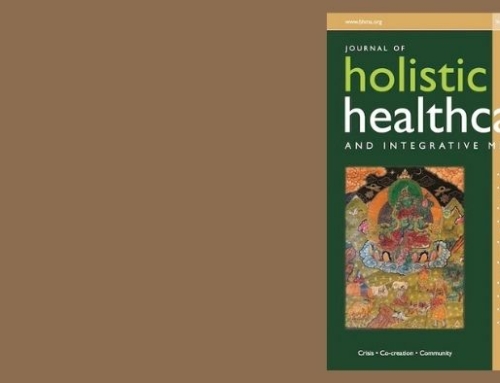By Angele Wallis, Child and adolescent psychotherapist. This article comes from the Journal of Holistic Healthcare, published by the British Holistic Medical Association. You can download our FREE journals and other resources at: bhma.org
Child analysis in the NHS helped a teenage girl’s disabling chronic mouth ulcers and migraines. In Jungian psychology individuation names the process through which the individual self develops out of an undifferentiated unconscious, so that the experiences of a person’s life become integrated over time into a well-functioning whole. In this case study the containment of a slowly growing two-year-long therapeutic relationship allowed Tia to trust another and herself enough to be able to think about her body and the contents of her mind, recall forgotten trauma, and make contact with split off emotions.
Humans have a tendency to experience body and mind as separate, despite compelling evidence to suggest that body and mind are one. Perplexing in their nature, psychosomatic disorders present a particular kind of conundrum for medics and psychotherapists (Kradin, 2011). It is not surprising that theoretical and therapeutic aspects of psychosomatic disorders remain challenging. As a child and adolescent psychotherapist in child and adolescent mental health services (CAMHS) working with children and young people with a range of emotional and behavioural difficulties, I have encountered the challenges of psychosomatic disorders, understood here as persistent physical symptoms affecting the child’s daily functioning, causing significant suffering but unexplained by medical testing.
In this paper I hold the view that complexities in the early caregiver – child interactions during infancy shape body and mind relationship in the child and throughout the lifespan. Through the case of Tia I hope to illustrate the usefulness of a multidisciplinary holistic approach in treating psychosomatic disorders in children, combining medication when appropriate with a talking cure, mirroring on some level the integrity of feelings and thoughts/body and mind. I hope to highlight the importance of empathy, the relevance of taking into account current stressors and allowing for the detailed reconstruction of early attachment patterns to unfold within the containment of a therapeutic relationship with the child.
The case of Tia:
Initial assessment
Tia was 14 years old when she was referred to CAMHS by the general hospital. She suffered from debilitating mouth ulcers which began appearing when she was a toddler. From the onset of puberty, she developed migraine headaches accompanied by vomiting and abdominal pain. Her referral highlighted that her father was an alcoholic and was on bail pending a court hearing for sexual assault. Her mother suffered from a chronic illness affecting her immune system with poor prognosis. I first met Tia and her mother with my psychiatrist colleague for an initial assessment. I then met with Tia alone over a three-week period for specialist assessment for psychotherapy.
Clinical presentation
Tia came to the clinic by herself. She presented as a pleasant but confused teenage girl. She spent much of her sessions describing her suffering from debilitating migraines and her painful mouth ulcers, explaining that despite several biopsies over the years her mouth ulcers remained undiagnosed. When her mouth ulcers flared up, the lining of her mouth was sore but not painful, she could not eat and required her food to be bland and liquidised, like a baby. When she did not have a flare-up of her mouth ulcers, Tia suffered from migraine headaches, preventing her from opening her eyes for at least a week. She was treated with various medications but these provided only temporary relief. Her view was that doctors were useless because they had not found anything wrong with her and she did not need psychotherapy.
In Tia’s eyes people were useless, unreliable and untrustworthy
At home and school, Tia’s relationships were impaired, largely devoid of intimacy and characterised by unsustained connections. On the rare occasions she spoke about aspects of her home life, she recounted with little affect memories from childhood and recent experience of domestic violence, abandonment by her abusive and alcoholic father’s unexplained absences and by her mother’s rejection. At school Tia’s attendance was poor partly due to her recurring flare up of mouth ulcers and migraine headaches. When she was able to attend, she had repeated outbursts of rage, although she could never recall having them. She was constantly falling out with peers, on several occasions punched someone in the face, causing a nosebleed and leading to her temporary exclusion from school. She appeared genuinely unable to recall any of these incidents, and in the same way had great deal of difficulty describing her internal sensations and feelings. I attributed this to a high level of dissociation and alexithymia — difficulty in experiencing, expressing, and describing emotional responses — which is a common feature in psychosomatic disorders. In Tia’s eyes people were useless, unreliable and untrustworthy, a view which I thought gave her a false sense of autonomy and power. Yet Tia also seemed crippled by her profound passivity and infantile need for attention and care, which her body was expressing through somatic symptoms.
Theoretical assumptions
I made the following considerations after assessing her for psychotherapy. Tia’s relationship with her caregivers severely frustrated her innate and fundamental needs for attachment. Her mother was emotionally distant and unexpressive and, I would think, upset and preoccupied with her own trauma and predicaments. Tia’s father was an extremely violent man unable to contain his own aggression and frustrations. This emotional climate and lack of containment lead to parts of Tia’s self becoming being split off and dissociated. Her inability to express her own archetypal primitive aggression created an internal pressure she was unable to manage. Tia adopted a number of sophisticated defences as ways of protecting herself from this internal pressure and from her external reality. However, at another level these defences significantly hindered her development, and thus compromised her individuation process. Tia’s migraines appeared to prevent her from thinking about her unbearable experiences. They forced her to shut down and not take anything in. In addition, her migraines and mouth ulcers made it hard for her to take in nourishment, physical and psychological, and prevented her from verbally expressing her distress and fury about her reality.
Evolution of therapy
Tia used her therapy to convey her dissociated feelings through behaviour in which she reversed the role of adult and child. She treated me like a child by painfully rejecting and abandoning me, making me feel like a neglected and isolated child, whose mother had no time for her at all. Her rejection and abandonment of me was expressed through her inconsistent and unpredictable attendance for therapy or by rejecting any reflection I made. At the very beginning of therapy she told me that she did not like to think about her feelings preferring, she said, to ‘sweep them aside’, which I thought reflected the depth of her psychosomatic splitting.
About three months into therapy, Tia’s difficulty in maintaining connection and the problem of regulating her closeness and distance with me rapidly surfaced. Tia’s modes of relating to me illustrated multiple confusions over her relationships with adults, and in parallel with this, confusion about her own body. It seemed that part of herself sometimes needed to be cared for, yet at the same time rejected the care she seemed to be longing for. Tia actively demonstrated to me how disconnected and out of touch she was with her feelings and acted out in therapy with me a fragmented and deprived caregiver–infant relationship. She could only regulate intimacy through physical means rather than psychological. It seemed that in infancy Tia felt cared for only in terms of surface attentions to her physical requirements and never experienced any psychological and intuitive sense of being held in her caregiver’s thoughts. In this context, Tia’s somatic symptoms prompted contacts with doctors which in turn provided her with something of the experience of adults caring and attending to her physical needs. This way she would passively and helplessly lie on a doctor’s couch while a biopsy would be taken from her mouth, perhaps a symbolic representation of her inability to use words to articulate the helplessness and emotional neglect she was experiencing with her caregivers. When doctors did not find anything wrong she would criticise them, seeing them as useless.
Tia’s inability to recall her outbursts of rage highlighted her tendency to dissociate when she encountered psychic distress. Most significantly any stressful situation she encountered was followed by debilitating migraines and painful mouth ulcers which prevented her from speaking or eating. This was also reflected in the pattern that, following a productive or creative therapy session, Tia would often miss the following session, as if to erase any understanding that had emerged and the possibility of further insight. Her unspoken frustration and repressed anger were feelings I picked up in our sessions (my ‘counter-transference’). In navigating through my responses to the rejecting and abandoning way she treated me, I gained an understanding of the part of Tia who felt deeply angry, let down and humiliated over her longing for a secure attachment. This split off or dissociated part of her desperately needed to be given expression but Tia could not allow herself to do this. This seemed to link with her feelings of shame that if she felt or expressed any aggression she would be rejected and punished, a very significant issue for Tia. As a way to manage her anxiety, she developed a paranoid resistance to getting close to me, as if I was her abusive father or her hostile and distant mother. This new understanding enabled me to endure the difficulties and to continue thinking about her, and to keep noticing and containing the rage and the despair that Tia brought to her sessions but which she was unable to process. I felt that it was important not to lose sight of Tia, largely because I feared that if I did she would not find the part of herself which strived for expression and needed to be integrated.
I gained an understanding of the part of Tia who felt deeply angry, let down and humiliated
As her therapy sessions became important to her, Tia became less rejecting of me. Her attendance improved and she was more receptive to my reflections, an indication that she appreciated the consistency of my presence. In this second phase of her therapy I began to understand that while Tia possibly longed for empathy and attunement with me, her suspicions and fears derived from her traumatic past experience of abandonment and emotional deprivation with her caregivers. This made it considerably difficult for her to engage deeply and fully utilise our therapeutic relationship. Although Tia seemed to want to form trusting relationships, it was apparent that for her, psychological contact itself was the fear element, perhaps because it brought a promise of love, safety and comfort that could not ultimately be fulfilled and this reminded her of the abrupt breaches of infancy she had experienced with her caregivers (Hedges, 1997). With this challenge in mind I saw my task with Tia as being to increase her ability to engage with me, first by respecting her need for limited emotional proximity and subsequently by paying careful attention to her levels of tolerance, which she communicated bodily and non-verbally, for example by sitting rigidly on the edge of her seat, or taking to bed with her migraine headaches, or through her mouth ulcers flaring up — an indication of psychic distress.
Approximately two years into twice-weekly therapy, memories of sexual abuse by her father began to surface. Tia recollected that when she was a young child her mother went to work leaving her at home in the care of her father. She remembered her father ‘always looking sleepy’ and recalled that he fondled her and obliged her to fondle him. Initially she thought the situation pleasurable but as time passed her father became more abusive. Afraid of what he might do to her and her mother (a result of living with domestic violence) Tia kept her mouth shut and did not tell her mother. When she did manage a disclosure to her mother, she was dismissed and not taken seriously. In recalling the sexual abuse by her father and her mother’s rejections and abandonment, Tia’s migraines returned. Her eyes closed, she described red lights around her and perceived volcanos and flowing lava flooding her. In the sessions which followed she began for the first time to get in touch with what she felt and confessed guilt, shame and angry feelings. Tia’s somatic symptoms gradually faded and by the end of her therapy, although her mouth ulcers still flared up, these episodes were few and far between. Her migraines had completely disappeared and her school attendance increased. With her emotional repertoire growing, Tia no longer had outbursts of rage at school as she could now put into words her feelings which meant that she could be understood by others. It seemed she no longer heavily relied on her body to speak out about her discomfort and distress.
Conclusion
Tia’s body and mind relationship had become fragmented as a result of her caregiver–infant experience. In the absence of an emotionally available adult’s mind to provide her with a ‘thinking skin’, Tia’s bodily sensations had failed to become thinkable emotions. As a result of this failure, her mind failed to develop a capacity to transform unprocessed psychic events into symbolic thoughts: to make sense of herself, in other words. Twice-weekly psychotherapy over two years allowed for the reconstruction of early attachment patterns to unfold within the containment of a therapeutic relationship, giving Tia the opportunity, with the help of her therapist, to think about her body and the contents of her mind in order to facilitate her re-integrating that which had become split off.







